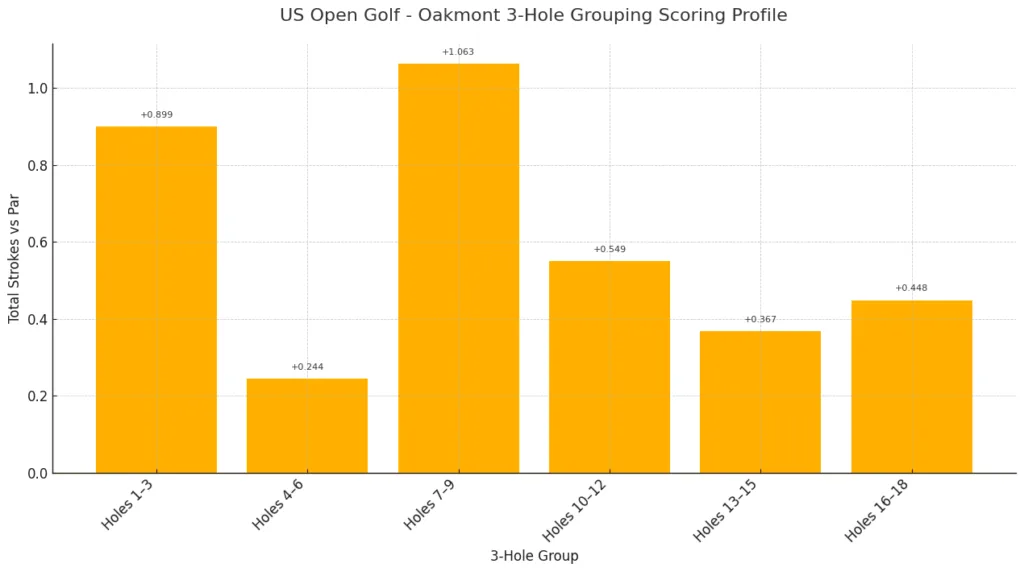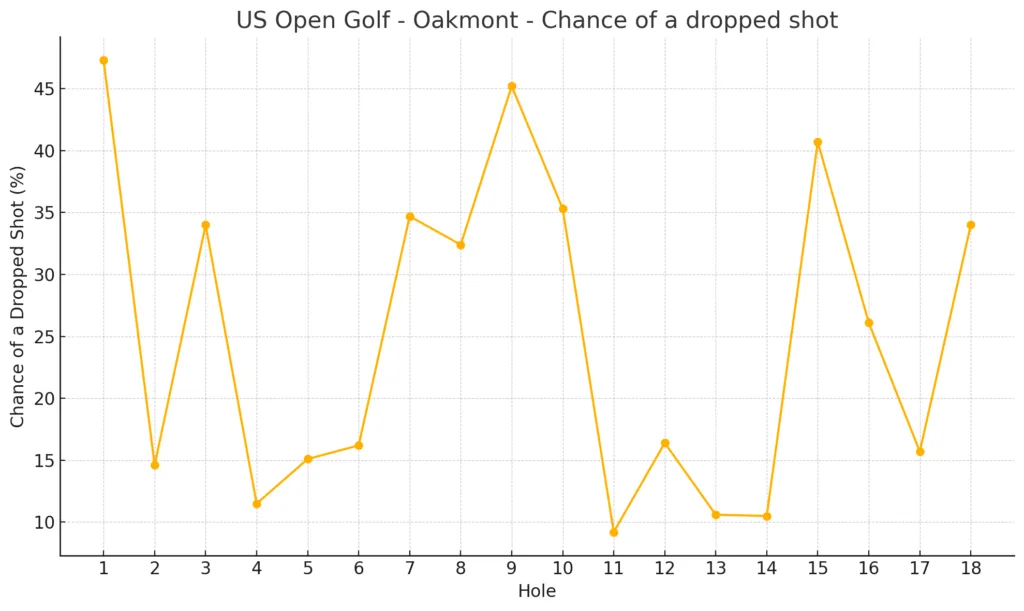
U.S. Open Golf 2025
Course Snapshot
- Venue: Oakmont Country Club, Pennsylvania
- Dates: 12th – 15th June 2025 (125th U.S. Open)
- Par / Yardage: 70 / 7,342 yds (back tees)
- Key characteristics:
- Lightning‑fast, canted greens stimping 13‑14 on tournament days
- 175 bunkers, including the iconic “Church Pews” between the 3rd & 4th fairways
- Penal primary rough (4 in +) and collar “ruff” around greens
Overview – Hard Starts & Harder Finishes
Oakmont is famously unrelenting: there is no water hazard and virtually no trees in play, yet scoring averages routinely creep above 75. The front nine opens with two bruising par‑4s before easing slightly around the turn; the back nine builds pressure before the drivable 17th offers a late swing.
Key yardages (tips)
| Hole | Par | Yards | Identity |
|---|---|---|---|
| 1 | 4 | 488 | One of golf’s toughest openers |
| 8 | 3 | 288 | Longest par‑3 in major history |
| 12 | 5 | 632 | True three‑shotter; precision over power |
| 17 | 4 | 312 | Easiest hole (stroke avg 3.89) |
| 18 | 4 | 484 | Uphill, dramatic finale |

The (Relatively) Friendly Stretch
Holes 11 – 14
After the gauntlet of 9 & 10, players exhale on 11 (400 yds). A visible, uphill landing area plus receptive green yielded Oakmont’s second‑lowest average in 2016 (4.07). 12 is lengthy, but because it is the lone par‑5 on the inward half, birdie percentages climb for long, straight hitters. 13 (par‑3, 183 yds) plays fractionally downhill. 14 (par‑4, 358 yds) has been rebuilt for 2025 with a narrowed landing zone but remains a “green‑light” wedge if the drive hugs the left rough line.
The Brutal Stretch
Opening Salvo – Holes 1 – 3
- 1st: Blind ridge, cross‑winds and a back‑sloping green quickly establish Oakmont’s tempo.
- 2nd: A 12‑bunker minefield where laying back leaves 200 + yds.
- 3rd: Redesigned for 2025; narrowed fairway and deeper front traps toughen an already exacting par‑4.
Mid‑Round Minefield – Holes 7 – 10
The par‑3 8th (288 yds) forces long‑iron or hybrid into a tabletop green; miss anywhere and bogey is generous. 9 & 10 are uphill, into prevailing wind, with step‑cut putting surfaces that repel from the centre.

Horses for Courses – Player Profiles That Fit
| Attribute | Why It Matters at Oakmont |
|---|---|
| Driving Accuracy ≥ 65 % | Narrow ribbons of fairway; recovery shots from 4‑inch rough seldom reach greens. |
| Ball‑striking (Approach‑Gained) | Greens demand precise landing spots below the hole; GIR is king. |
| Lag Putting (> 25 ft) | Three‑putt avoidance pivotal on 6,500 sq‑ft greens rolling at 14 on the Stimpmeter. |
| Mental Resilience | Historic winning scores average just –2; bogey is acceptable, doubles are fatal. |
Punters should favour methodical tacticians over raw bombers. Think Scottie Scheffler’s tee‑to‑green dominance or Matt Fitzpatrick’s fairway‑first mantra. Long‑odds outsiders with elite scrambling numbers – e.g., Brian Harmon – could surprise if conditions firm up.
Betting & Trading Angles
- Early‑morning tee‑times traditionally post the week’s lowest rounds before greens bake.
- Trading window: between holes 11‑14; momentum can swing from red numbers into the calamitous 15‑16 gauntlet.
- Round‑by‑round match‑ups favour steady par merchants; volatility on 17‑18 suits underdog chasers.
Final Word
Oakmont does not reward finesse alone, nor brute strength in isolation; it crowns the player who absorbs its blows, chooses bravery selectively, and putts fearlessly on glass‑like greens. Expect the winning score to hover around level par and the champion’s closing stretch to pivot on one nerveless swing at the drivable 17th.
